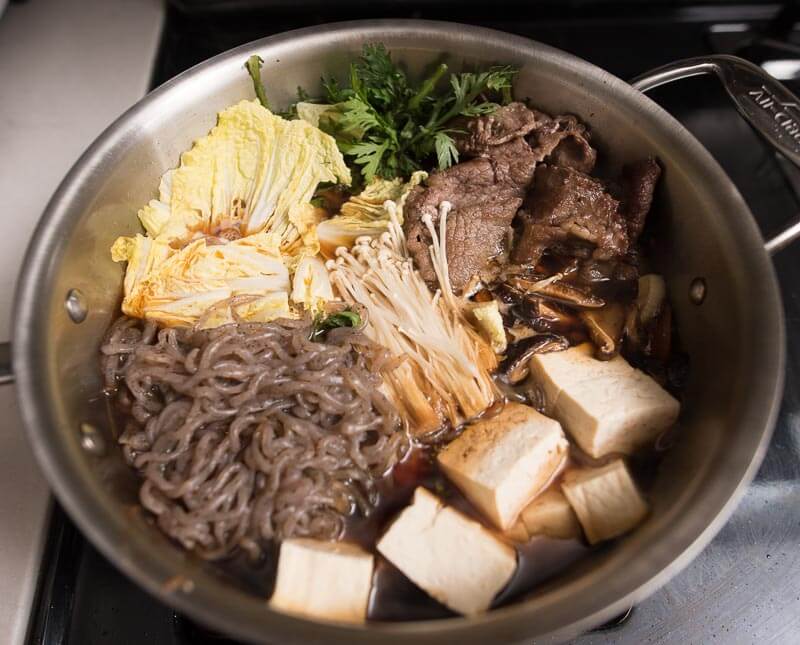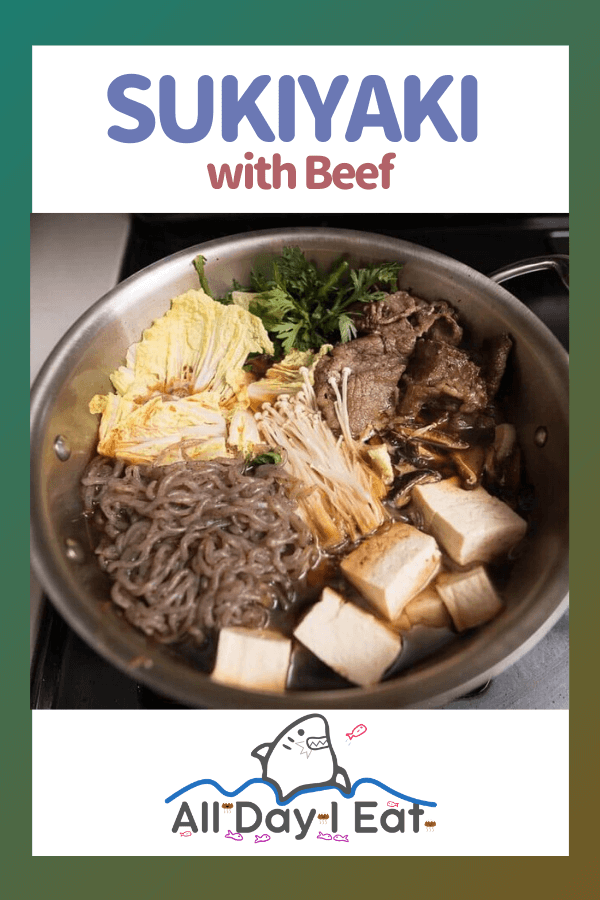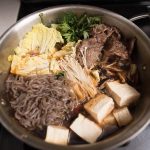Sukiyaki is one of my favorite comfort foods and is the perfect way to stay warm on a cold winter night. Even better is how good it tastes. Even better than that? How easy it is to make at home! Join me later today as I cook it with you live! Hope to see you in my kitchen!

Sukiyaki (すき焼き)
We’re hosting another Cook with Pat today and this time we’re making Sukiyaki!(すき焼き)
There are plenty of warm comfort foods eaten in Japan during the winter.
And this is one of them.
Really, the hardest part?
At least for me, is chopping the vegetables.
That’s all there is to it really.
Just don’t chop your finger.
Just the vegetables.
After that, it’s just mixing in some ingredients to make the sauce!
And your dinner will be ready in no time.
All you need is a bowl of rice! Or….. udon noodles~

Where does the name Sukiyaki come from?
Back in the Edo period, it’s said that farmer’s cooked tofu and fish on their tool suki( 鋤)
A suki I guess is like a spade and they held it over the fire to yaki (焼き)cook their food.
Hence, the name sukiyaki!
You can add whatever you fancy to the pot and it will probably all taste good. BUT!
The most common ingredients include vegetables, tofu, shirataki noodles, and meat.
For the vegetables, you can’t go wrong with napa cabbage and onion!
Though big and leafy, once napa cooks down it’s soft and easy to eat.
And the onions are a good way to add depth and complexity to the overall flavor profile.
The tofu add their it’s own unique color and texture to the mix, as well as, a healthy source of protein.
The beef adds plenty of meaty flavor as well as fat.
The shirataki noodles are also a fun bunch.
They’re squigly and chewy.
They don’t smell so hot out of the bag, but once you drain and cook it’s not at all noticeable.
Last, the other goods I usually like to put in are eggs and green onions.
Raw egg is my favorite but raw egg consumption isn’t that common in the US.
So eat at your own risk!
How to make Sukiyaki
You can make it on the stove like I did or if you have a table top electric stove, do that too.
A portable gas stove works as well, but it’s a bit more cumbersome. I mean, do you really want to be using gas canisters when you have a stove?? Not me! :0
The best part about using the electric stove is eating at the table when it’s super hot.
I do that when I go to my parents house.
The other good thing about it is that you can refill and keep cooking more vegetables.
Since I don’t have one of those, I just make my sukiyaki on the stove and serve it in a bowl.
Just do whatever works for you!

6 tips for making sukiyaki:
- Choose the right type of meat: Sukiyaki is traditionally made with thinly sliced beef, but you can also use pork or chicken. Choose a high-quality, tender cut of meat for the best results.
- Slice the meat and vegetables thinly: It is important to slice the meat and vegetables thinly for sukiyaki, as they will cook quickly in the broth.
- Make the broth: Sukiyaki broth is typically made by combining dashi broth, sake, sugar, and soy sauce. Adjust the ratio of these ingredients to your taste.
- Cook the ingredients in the broth: Place the sliced meat and vegetables in the broth and cook until they are tender. You can also add noodles, such as udon or soba, to the broth towards the end of cooking.
- Serve the sukiyaki hot: Sukiyaki is typically served hot, with the broth and cooked ingredients ladled over a bowl of rice.
- Adjust the seasoning to taste: Taste the sukiyaki as it cooks and adjust the seasoning to your liking. You can add more sugar for sweetness, more soy sauce for saltiness, or more sake for depth of flavor.
Here is the link to the replay – I had some technical difficulties so I apologize if you had issues when trying to join or participate!
My sukiyaki recipe can be found below.
Hope you get a chance to try it!
See you live at 5PM PST next Thursday on either my Facebook page or Youtube channel!
PrintHow to Make Sukiyaki with Beef (Japanese Hot Pot)
- Prep Time: 15 minutes
- Cook Time: 20 minutes
- Total Time: 35 minutes
- Yield: 4 people 1x
- Category: Main Dish
- Cuisine: Japanese
Ingredients
Vegetables and meat
- 2–3 stems shungiku ((Chrysanthemum greens, small branches/leaves only))
- 10–15 leaves napa cabbage (chopped into 1 in pieces)
- 1 piece Tokyo Negi ( (large fat Japanese green onions, regular green onion can be subbed!))
- 1 cup sliced onions
- 4–6 whole shiitake mushrooms (sliced)
- 1 package firm Tofu (14 oz, drained cut into 1/2–1 in cubes)
- 1–2 packages shirataki noodles (14 oz each, white or brown)
- 1 package enoki mushrooms
- 1/2 lb thinly sliced beef (i like ribeye)
Warishita (割りした – sukiyaki stock)
- 200 mL mirin
- 200 mL soy sauce
- 200 mL dashi stock (or water + more, if broth gets too low)
- 2–3 tsp sugar
For serving
- white rice (or udon (1/2 package per person))
- shichimi (Japanese pepper (optional))
Instructions
- First we are going to wash and cut all the vegetables.
- The napa cabbage, shungiku should be sliced into 1/2 inch pieces. The tokyo negi or green onion can be cut into 1 inch or 1.5 inch pieces. The onions should be sliced about 1/4 thick. The bottom growing pad where the enoki mushrooms grew can be cut off. The shiitake mushrooms, if using dry should be reconstituted, and then sliced about 1/2 in thick.
- The tofu should be cut into blocks about 1/2-1inch. thick depending on your preference. Allow excess water to drain.
- Shirataki noodles should be drained and rinsed.
- After prepping all the vegetables, let’s mix the sauce. The ratio I used is 1:1:1 mirin, soy sauce and water. I don’t like my sauce sweet so I only add a little bit of sugar. You can use dashi if you want a more complex flavor or water if you want something less complex.
- First thing we are going to cook is the beef, we’ll sear the beef on both sides and set aside. After searing the beef, well cook the onions until they get a nice browning on the surface.
- After the beef has been seared and green onions cooked, we’ll add it back to the pot and can add in the sauce and all the vegetables.
- Simmer on medium low heat until heated through. About 15-20 minutes.
- (While the vegetables cook, you can cook your udon.)
- Once your vegetables are cooked you can drop in scrambled egg and let it cook slightly, or if you like living on the edge, eat it raw with the sukiyaki.
- Serve with udon noodles or rice!









Konnichiwa! (Hello!) I'm Pat Tokuyama, a Japanese tofu cookbook author, who travels for music, food, and adventure. If you like Japanese tea, checkout some of the newestorganic japanese tea, matcha bowls and noren and more!
** Curious about the Plant Based Japanese Cooking Club? ** Learn more here!